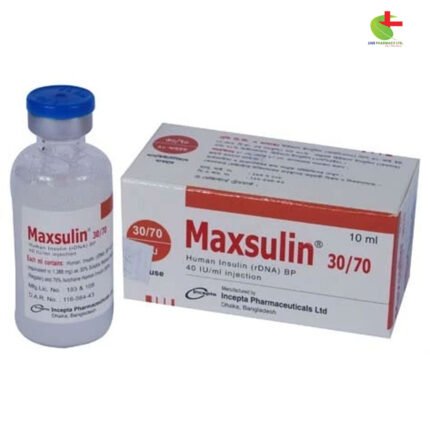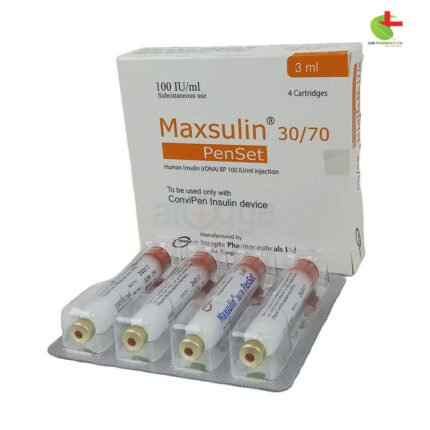Maxsulin N
195.00৳ Injection
- Maxsulin N is a medium-acting insulin indicated for the treatment of type 1 and type 2 diabetes, as well as gestational diabetes.
- It helps regulate blood glucose levels, particularly during stressful conditions such as infections or surgery.
- Available in multiple formulations, Maxsulin N ensures effective management of diabetes under medical supervision.
 Brand
Brand
|
Incepta Pharmaceuticals Ltd |
|---|---|
 Generics
Generics
|
Insulin Human [rDNA] |
 Type
Type
|
SC Injection |
Indications
Maxsulin N Injection is prescribed for:
- Managing type 1 diabetes in all patients.
- Treating type 2 diabetes that remains uncontrolled with diet and/or oral hypoglycemic medications.
- Initial stabilization of diabetes in cases of diabetic ketoacidosis, hyperosmolar non-ketotic syndrome, and during stressful events such as severe infections and major surgeries in diabetic patients.
- Managing gestational diabetes.
Always consult a registered physician before using this medication.
Composition
Maxsulin N Injection contains:
- Insulin Human R (40 IU/ml): Each ml contains 40 IU (1.388 mg) of Insulin Human (rDNA) USP as Soluble Insulin Human (Regular).
- Insulin Human R (100 IU/ml): Each ml contains 100 IU (3.47 mg) of Insulin Human (rDNA) USP as Soluble Insulin Human (Regular).
- Insulin Human N (40 IU/ml): Each ml suspension contains 40 IU (1.388 mg) of Insulin Human (rDNA) USP as Isophane Insulin Human.
- Insulin Human N (100 IU/ml): Each ml suspension contains 100 IU (3.47 mg) of Insulin Human (rDNA) USP as Isophane Insulin Human.
Pharmacology
Maxsulin N is a sterile, clear, and colorless insulin solution that acts quickly and has a relatively short duration compared to other insulins. It can be combined with long-acting insulins. Insulin reduces blood glucose levels by promoting glucose uptake in muscle and fat cells while inhibiting hepatic glucose output.
- Half-life: A few minutes in the bloodstream, with minimal binding to plasma proteins.
- Action Profile after Subcutaneous Injection:
- Onset: Within 30 minutes
- Peak Levels: 1-3 hours
- Duration: Approximately 4-6 hours
Dosage
Dosage is personalized based on the patient’s needs and determined by a physician.
- For type 1 diabetes, the average total daily insulin requirement typically ranges from 0.5 to 1.0 IU/Kg. In pre-pubertal children, this may be 0.7 to 1.0 IU/Kg.
- Type 2 diabetes patients may start with lower dosages, around 0.3 to 0.6 IU/Kg/day.
- An injection should be followed by a meal or snack containing carbohydrates within 30 minutes.
Always follow a registered physician’s advice when using this medication.
Administration
- Route: Usually administered subcutaneously in the abdominal wall; other sites include the thigh, gluteal region, or deltoid region.
- Site Selection: Subcutaneous injections in the abdominal wall facilitate faster absorption. Rotate injection sites within an anatomical region to prevent lipodystrophy.
- Special Guidance: Intramuscular and intravenous administrations should be conducted under medical supervision.
Dosage Adjustment
- Factors such as infections, fever, renal or hepatic impairment, and changes in physical activity or diet may necessitate dosage adjustments.
- Changes when switching between insulin preparations should be monitored closely by a healthcare provider.
Consult a registered physician for any dosage adjustments.
Interaction
Certain medications can influence insulin requirements:
- Reducing Insulin Needs: Oral hypoglycemic agents (OHA), monoamine oxidase inhibitors (MAOI), non-selective beta-blockers, ACE inhibitors, salicylates, and alcohol.
- Increasing Insulin Needs: Thiazides, glucocorticoids, thyroid hormones, beta-sympathomimetics, growth hormone, and danazol.
- Important Note: Beta-blockers may mask hypoglycemia symptoms and delay recovery. Alcohol can prolong insulin’s hypoglycemic effects.
Contraindications
Maxsulin N should not be administered to patients experiencing hypoglycemia or those who are hypersensitive to human insulin or any excipients.
Side Effects
Adverse reactions from human insulin usage are primarily dose-dependent and related to its pharmacological effects. Common side effects include:
- Hypoglycemia: The most frequent and serious effect, often due to excessive insulin dosage.
- Lipodystrophy: May occur at injection sites if rotation is not practiced.
- Hypersensitivity: Symptoms may include skin rash, itching, gastrointestinal upset, angioedema, difficulty breathing, palpitations, and blood pressure changes.
- Edema: May occur when initiating insulin therapy and is generally transient.
Pregnancy & Lactation
Insulin treatment during pregnancy is safe as it does not cross the placenta. Hypoglycemia and hyperglycemia from poorly managed diabetes can increase risks of malformations and fetal death. Insulin requirements typically decrease in the first trimester and increase in the second and third. Post-delivery, insulin levels return to pre-pregnancy values.
Precautions & Warnings
- Inadequate dosing or discontinuation of treatment in type 1 diabetes can lead to severe hyperglycemia, ultimately resulting in diabetic ketoacidosis.
- Hypoglycemia risk increases with excessive insulin dosages.
- Switching insulin types or brands must occur under medical supervision, as different formulations may alter insulin requirements.
- Patients should consult their doctor before traveling across time zones.
Overdose Effects
While specific overdose definitions for Maxsulin N are absent, hypoglycemia can develop in stages:
- Mild Cases: Treated with oral glucose or sugary products.
- Severe Cases: Require glucagon (0.5 to 1 mg) administered by a trained individual or intravenous glucose from a medical professional. If unconscious, immediate medical assistance is essential.
Once consciousness is regained, oral carbohydrates should be provided to prevent relapse.
Therapeutic Class
Medium-Acting Insulin
Storage Conditions
Maxsulin N preparations should be stored in a refrigerator between 2°C and 8°C. Do not use preparations that have been frozen. Keep in the outer carton to protect from light, and avoid excessive heat or sunlight. Solutions should not be used if they appear cloudy or discolored. Once in use, the vial can be kept at room temperature (below 25°C) for up to 6 weeks or at up to 30°C for 4 weeks.













Reviews
There are no reviews yet.